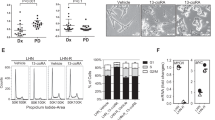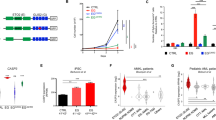Abstract
Retinoic acid (RA) has been shown to induce neuronal differentiation and/or apoptosis, and is widely used as a chemotherapeutic agent for treating the patients with neuroblastoma. However, the therapeutic effect of RA is still limited. To unveil the molecular mechanism(s) inducing differentiation and apoptosis in neuroblastoma cells, we compared CHP134 and NB-39-nu cell lines, in which all-trans-RA (ATRA) induces apoptosis, with LA-N-5 and RTBM1 cell lines, in which it induces neuronal differentiation. Here, we found that Bcl-2 was strongly downregulated in CHP134 and NB-39-nu cells, whereas it was abundantly expressed in LA-N-5 and RTBM1 cells. ATRA-mediated apoptosis in CHP134 and NB-39-nu cells was associated with a significant activation of caspase-9 and caspase-3 as well as cytoplasmic release of cytochrome c from mitochondria in a p53-independent manner. Enforced expression of Bcl-2 significantly inhibited ATRA-mediated apoptosis in CHP134 cells. In addition, treatment of RTBM1 cells with a Bcl-2 inhibitor, HA14-1, enhanced apoptotic response induced by ATRA. Of note, two out of 10 sporadic neuroblastomas expressed bcl-2 at undetectable levels and underwent cell death in response to ATRA in primary cultures. Thus, our present results suggest that overexpression of Bcl-2 is one of the key mechanisms to give neuroblastoma cells the resistance against ATRA-mediated apoptosis. This may provide a new therapeutic strategy against the ATRA-resistant and aggressive neuroblastomas by combining treatment with ATRA and a Bcl-2 inhibitor.
This is a preview of subscription content, access via your institution
Access options
Subscribe to this journal
Receive 50 print issues and online access
$259.00 per year
only $5.18 per issue
Buy this article
- Purchase on Springer Link
- Instant access to full article PDF
Prices may be subject to local taxes which are calculated during checkout





Similar content being viewed by others
References
Abel F, Sjoberg RM, Nilsson S, Kogner P, Martinsson T . (2005). Eur J Cancer 41: 635–646.
Antonsson B . (2001). Cell Tissue Res 306: 347–361.
Balmer JE, Blomhoff R . (2002). J Lipid Res 43: 1773–1808.
Brodeur GM . (2003). Nat Rev Cancer 3: 203–216.
Brodeur GM, Nakagawara A . (1992). Am J Pediatr Hematol Oncol 14: 111–116.
Cory S, Huang DC, Adams JM . (2003). Oncogene 22: 8590–8607.
Culmsee C, Mattson MP . (2005). Biochem Biophys Res Commun 331: 761–777.
Degterev A, Boyce M, Yuan J . (2003). Oncogene 22: 8543–8567.
Dole M, Nunez G, Merchant AK, Maybaum J, Rode CK, Bloch CA et al. (1994). Cancer Res 54: 3253–3259.
Encinas M, Iglesias M, Llecha N, Comella JX . (1999). J Neurochem 73: 1409–1421.
Freemantle SJ, Spinella MJ, Dmitrovsky E . (2003). Oncogene 22: 7305–7315.
Gallo G, Giarnieri E, Bosco S, Cappelli C, Alderisio M, Giovagnoli MR et al. (2003). Anticancer Res 23: 777–784.
Kim R, Emi M, Tanabe K, Toge T . (2004). Cancer 101: 2491–2502.
Lee MH, Nikolic M, Baptista CA, Lai E, Tsai LH, Massague J . (1996). Proc Natl Acad Sci USA 93: 3259–3263.
Lippman SM, Lotan R . (2000). J Nutr 130: 479S–482S.
Lombet A, Zujovic V, Kandouz M, Billardon C, Carvajal-Gonzalez S, Gompel A et al. (2001). Eur J Biochem 268: 1352–1362.
Lopez-Carballo G, Moreno L, Masia S, Perez P, Barettino D . (2002). J Biol Chem 277: 25297–25304.
Maden M . (2001). Int Rev Cytol 209: 1–77.
Matthay KK, Villablanca JG, Seeger RC, Stram DO, Harris RE, Ramsay NK et al. (1999). N Engl J Med 341: 1165–1173.
McCaffery PJ, Adams J, Maden M, Rosa-Molinar E . (2003). Eur J Neurosci 18: 457–472.
Melino G, Thiele CJ, Knight RA, Piacentini M . (1997). J Neurooncol 31: 65–83.
Morishima N, Nakanishi K, Takenouchi H, Shibata T, Yasuhiko Y . (2002). J Biol Chem 277: 34287–34294.
Nagai J, Yazawa T, Okudela K, Kigasawa H, Kitamura H, Osaka H . (2004). Cancer Res 64: 7910–7917.
Nakagawa T, Zhu H, Morishima N, Li E, Xu J, Yankner BA et al. (2000). Nature 403: 98–103.
Nakagawara A . (1998). Hum Cell 11: 115–124.
Nakagawara A, Arima-Nakagawara M, Scavarda NJ, Azar CG, Cantor AB, Brodeur GM . (1993). N Engl J Med 328: 847–854.
Nakagawara A, Azar CG, Scavarda NJ, Brodeur GM . (1994). Mol Cell Biol 14: 759–767.
Nakagawara A, Nakamura Y, Ikeda H, Hiwasa T, Kuida K, Su MS et al. (1997). Cancer Res 57: 4578–4584.
Nakamura Y, Ozaki T, Koseki H, Nakagawara A, Sakiyama S . (2003). Biochem Biophys Res Commun 307: 206–213.
Nikolaev AY, Li M, Puskas N, Qin J, Gu W . (2003). Cell 112: 29–40.
Okuno S, Saito A, Hayashi T, Chan PH . (2004). J Neurosci 24: 7879–7887.
Oltersdorf T, Elmore SW, Shoemaker AR, Armstrong RC, Augeri DJ, Belli BA et al. (2005) . Nature 435: 677–681.
Ostermeyer AG, Runko E, Winkfield B, Ahn B, Moll UM . (1996). Proc Natl Acad Sci USA 93: 15190–15194.
Piacentini M, Annicchiarico-Petruzzelli M, Oliverio S, Piredda L, Biedler JL, Melino G . (1992). Int J Cancer 52: 271–278.
Puthalakath H, Villunger A, O'Reilly LA, Beaumont JG, Coultas L, Cheney RE et al. (2001). Science 293: 1829–1832.
Reynolds CP, Lemons RS . (2001). Hematol Oncol Clin N Am 15: 867–910.
Romani P, Lu QL . (1994). J Pathol 172: 273–278.
Schor NF . (1999). J Neurooncol 41: 159–166.
Shi L, Gong S, Yuan Z, Ma C, Liu Y, Wang C et al. (2004). Neurosci Lett 375: 7–12.
Takada N, Isogai E, Kawamoto T, Nakanishi H, Todo S, Nakagawara A . (2001). Med Pediatr Oncol 36: 122–126.
Teitz T, Wei T, Valentine MB, Vanin EF, Grenet J, Valentine VA et al. (2000). Nat Med 6: 529–535.
Thiele CJ, Reynolds CP, Israel MA . (1985). Nature 313: 404–406.
Van Noesel MM, Van Bezouw S, Voute PA, Herman JG, Pieters R, Versteeg R . (2003). Genes Chromosomes Cancer 38: 226–233.
Van Noesel MM, Versteeg R . (2004). Gene 325: 1–15.
Villablanca JG, Khan AA, Avramis VI, Seeger RC, Matthay KK, Ramsay NK et al. (1995). J Clin Oncol 13: 894–901.
Wang JL, Liu D, Zhang ZJ, Shan S, Han X, Srinivasula SM et al. (2000). Proc Natl Acad Sci USA 97: 7124–7129.
Acknowledgements
We are grateful to the hospitals and institutions that provided us with surgical specimens. We thank Hideki Yamamoto and Atsushi Kawasaki for valuable discussions, and Yuki Nakamura for excellent technical assistance. This work was supported in part by a Grant-in-Aid from the Ministry of Health, Labour and Welfare for Third Term Comprehensive Control Research for Cancer, and a Grant-in-Aid for Scientific Research on Priority Areas and a Grant-in-Aid for Scientific Research (C) from the Ministry of Education, Culture, Sports, Science and Technology, Japan.
Author information
Authors and Affiliations
Corresponding author
Rights and permissions
About this article
Cite this article
Niizuma, H., Nakamura, Y., Ozaki, T. et al. Bcl-2 is a key regulator for the retinoic acid-induced apoptotic cell death in neuroblastoma. Oncogene 25, 5046–5055 (2006). https://doi.org/10.1038/sj.onc.1209515
Received:
Revised:
Accepted:
Published:
Issue Date:
DOI: https://doi.org/10.1038/sj.onc.1209515
Keywords
This article is cited by
-
Master regulator analysis of paragangliomas carrying SDHx, VHL, or MAML3 genetic alterations
BMC Cancer (2019)
-
The p53 activator overcomes resistance to ALK inhibitors by regulating p53-target selectivity in ALK-driven neuroblastomas
Cell Death Discovery (2018)
-
EZH2 regulates neuroblastoma cell differentiation via NTRK1 promoter epigenetic modifications
Oncogene (2018)
-
Changes in Cell Cycle and Up-Regulation of Neuronal Markers During SH-SY5Y Neurodifferentiation by Retinoic Acid are Mediated by Reactive Species Production and Oxidative Stress
Molecular Neurobiology (2017)
-
BMCC1, which is an interacting partner of BCL2, attenuates AKT activity, accompanied by apoptosis
Cell Death & Disease (2015)



